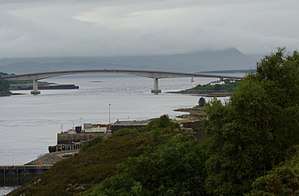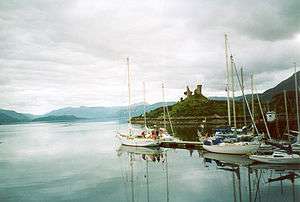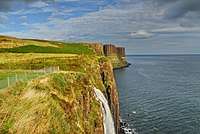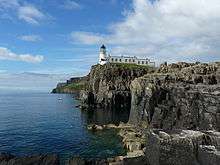Skye
Skye (Gaelic: An t-Eilean Sgitheanach) is the largest and most northerly of the Inner Hebrides off the west coast of Scotland, linked to the mainland by a toll-free bridge. It's a rugged mountainous island with spectacular scenery, with Portree its main village.

Villages
Sleat is the gently rolling southern part of Skye where almost all visitors first arrive. Most use the road bridge from Kyle of Lochalsh to 🌍 Kyleakin. Once the main ferry port, it's now a quiet place with a small castle. Towards the southern tip of Sleat, 🌍 Armadale has ferries from Mallaig on the mainland. Both routes converge on 🌍 Broadford.
Minginish is the central body of Skye, grouped around the dramatic Cuillin mountain range. A lane runs west from Broadford to 🌍 Elgol from where you can take a boat to Loch Coruisk and walk to the fine beach at Camasunary. The main road hugs the north / east coast, passing through Sconser (with ferries to Raasay) and 🌍 Sligachan. From here a road branches west towards 🌍 Carbost on Loch Harport, home of the Talisker whisky distillery. Side lanes wind inland to 🌍 Glenbrittle, a good base for climbing the Cuillin.
🌍 Portree is the main village of Skye, and has the most accommodation and other amenities. North of here, the island breaks into three stubby fingers.
Trotternish is the largest and most frequently visited of these, having the stunning rock formations of the Old Man of Storr and the Quiraing. The A855 (and buses) circumnavigate this beautiful area, with plenty of options for walking and climbing. You also come this way to reach 🌍 Uig, ferry port for the Outer Hebrides. Uig has a notable brewery, the Fairy Glen and the Skye Museum of Island Life.
Waternish in the middle has some pretty villages, especially 🌍 Stein, but is often overlooked by tourists. See also the ruins of Trumpan church.
Duirnish is the peninsula west of 🌍 Dunvegan, best known for Dunvegan Castle. Further up the lane are Glendale and 🌍 Colbost. The lane ends at Milovaig but you can hike to the lighthouse at Neist Point.
Understand
The island comprises a series of peninsulas that radiate from the mountainous centre of the Cuillin hills. Occupied since the Mesolithic era, about 9,200 people live on the island, although the transient population of tourists swells during the busy summer months. Skye's popularity with tourists is largely due to its remarkable landscape and easy accessibility from the mainland, both by car over the Skye Bridge or by ferry; and by bus and train through adjacent mainland towns.
The island is renowned for its spectacular scenery, vibrant culture and heritage, and its abundant wildlife including the Golden Eagle, Red Deer and Salmon. It is also one of the most accessible regions in which to hear Gaelic being spoken, with about 30% of the local population being fluent and a sizeable Gaelic college in Sleat.
There is a tourist information centre in Portree.
Get in

By plane
Skye has no air service. The nearest mainland airports are Inverness, Glasgow and Edinburgh.
By car
The main road to Skye is the A87, which branches off A82 (Fort William-Inverness road) at Invergarry, to run west via Shiel Bridge (for Glenelg), Dornie (for Eilean Donan Castle) and Kyle of Lochalsh, crossing the toll-free bridge to Kyleakin. It follows Skye's north coast via Broadford and Portree to Uig.
Or take the A830 "Road to the Isles" from Fort William via Glenfinnan to Mallaig and thence by ferry to Armadale as described below.
By bus
Scottish Citylink Bus 914 / 915 runs twice daily between Glasgow and Skye. The route north is from Buchanan St Station via Glasgow Airport, Dumbarton, Loch Lomond west bank, Crianlarich, Glencoe, Fort William, Invergarry and Kyle of Lochalsh. The route continues across Skye via Broadford, Sligachan and Portree to Uig, about 7 hours in total.
Bus 916 / 917 runs twice daily from Inverness via Loch Ness and Kyle, then via Broadford and sligachan to Portree; 3 hours 30 mins.
Stagecoach Highlands Bus 55 runs three times M-F from Kyle to Kyleakin and Broadford, with two continuing to Torrin and Elgol.
Bus 51 / 52 runs from the ferry pier at Armadale to Broadford and Portree several times a day.
By train
There is no railway on Skye. The two mainland stations with connections to Skye are 🌍 Kyle of Lochalsh and 🌍 Mallaig. From London they're both about 11 hours by daytime train, 13 hours via sleeper. Kyle has trains from Inverness, and is the better linked, with buses onward to Skye. Mallaig has trains from Fort William and Glasgow; from Mallaig you take the ferry to Armadale as described below, then a bus.
By ferry
Calmac car ferries ply between Mallaig on the mainland and Armadale near the south tip of Skye. They take 45 mins and sail daily, every hour or two Apr-Oct but only a couple per day Nov-March. Fares are about £10 per car plus £3 per person.
The tiny Skye Ferry runs April to mid-October between Glenelg on the mainland and Kylerhea, which is up a minor road south of Kyleakin. It's an odd contraption, with a swivelling deck, and its capacity is only six cars per trip or 18 per hour; there's no bus from Kylerhea. This ferry is best regarded as a tourist sight, not a practical transport option.
From Uig in the north of Skye, Calmac car ferries sail to Tarbert on Harris and Lochmaddy on North Uist - buses from Glasgow and Inverness traverse Skye to connect with these ferries. Those Outer Hebrides can be reached by other routes from the mainland (chiefly Ullapool to Stornoway, and Mallaig to Lochboisdale - see relevant pages "Get in" for details); so you could reach Skye that roundabout way.
There's also a ferry between Sconser on Skye and the little island of Raasay. But there's no other way on or off that island so you have to double back.
Get around
By bus
The rural network of local buses is provided by Stagecoach Highlands (who acquired the local operator Rapsons in 2008). A Stagecoach Highlands Skye route map is available online.
North Skye routes include the following services (see Stagecoach Highlands timetable for North Skye routes 54, 56, 57A/57C, 58/158 and 59):
- 54 - Portree / Carbost (and the Talisker Distillery) / Fiscavaig: only operates once a day per direction from Mon-Fri (on schooldays) leaving Fiscavaig in the morning and Portree in the afternoon.
- 56 - Portree / Dunvegan / Lonmore / Glendale: operates M-F and Sa, no service on Su.
- 57C (clockwise) & 57A (anti-clockwise) - Portree / Uig / Flodigarry Peninsula / Portree: operates M-F and Sa, no service on Su; for Old Man of Storr, the Quiraing, Kilt Rock and Uig
- 58 - Portree town service & 158 - Portree School bus: operates only M-F.
- 59 - Portree / Peinchorran: operates only M-F.
- 60X (morning) - Portree / Sligachan / Dunvegan Castle / Portree: operates in summer only (about end-June till the beginning of September); daily (except Wed) at 10:45 (duration: 3 hr) with a 1-hr break at Dunvegan Castle and a 20-min break at Sligachan.
- 60X (afternoon) - Portree / Kilt Rock / Portree: operates in summer only (about end-June till the beginning of September); daily (except Wed) at 14:45 (duration: 2½ hr) with a 10-min break at Kilt Rock.
South Skye routes include the following services (see Stagecoach Highlands timetable for South Skye routes 55, 152, 155, 164):
- 49, 49B Portree / Elgol
- 50, 55 Portree / Kyle of Lochalsh (for coach and train connections to Inverness, and coach connections to Fort William and Glasgow),
- 52, 52C Portree / Broadford / Armadale (for ferry connections to/from Mallaig and trains to Fort William and Glasgow)
- 164 - Ardaneaskkan / Lochcarron / Plockton / Kyle of Lochalsh: operates once a day per direction Mon-Fri (on schooldays); leaves Ardaneaskan in the morning and Kyle of Lochalsh in the afternoon.
Fares rise by distance travelled, with a half-hour journey usually costing around £3. There is an £8.25 dayrider ticket (which will normally make sense if you are using more than two buses in one day) and a 7-day megarider ticket for £32. Both types of tickets are only valid on Stagecoach Highlands buses on Skye and Lochalsh. Ask the bus driver for your best option. For an overview of ticket options for the general Stagecoach Highlands area check online.
An area guide for Skye and Lochalsh lists all bus times, and is issued twice annually for winter and summer seasons. It can be downloaded in pdf format from Stagecoach Highlands by clicking on 'Timetables' and then scrolling down to 'Skye and Lochalsh' or picked up in paper form from buses and tourist information centres. It is strongly recommended to check times in advance, paying special attention to any timetable notes relating to days when the bus runs or does not.
Although they are listed alongside local buses in journey planners and at bus stops, passengers should avoid taking Scottish Citylink coaches for journeys wholly within Skye or across the bridge to Kyle of Lochalsh since fares are substantially cheaper on local services.
Use Travelline Scotland to plan your journey and get timetables.
By car
Although substantial European and Scottish funding has been made available to improve and widen certain key routes (most recently the southern section of the Armadale to Broadford road), major roads are still quite narrow and can get congested in high season. However in low season driving in Skye is a delight with only the occasional sheep wandering onto the tarmac to concern you. On narrow single track rural roads pay attention to passing places and drive courteously, being ready to pull over to allow an oncoming vehicle to pass.
Car hire is available in Portree and Kyle of Lochalsh, but can be expensive. When travelling to the island in the high season, call ahead for availability:
- Skye Car Hire and Kyle Taxi, 4B Station Road, Kyle of Lochalsh, ☎ +44 1599 534323, e-mail: kyletaxis@aol.com. Starting from £40 per day and £240 per week.
- Morrison Car Hire, ☎ +44 1478 612688. Starting from £40 with insurance excess of £250. Car pick-up points can be arranged at various locations.
- Morar Motors, ☎ +44 1687 462118. Available in Mallaig or Kyle of Lochalsh.
By bicycle
Many of the roads in Skye are well cyclable, although traffic can be a problem in late summer. If you're cycling, make sure you have good raingear; Skye is wet even by the drizzly standards of Scotland. The ferry from Mallaig accepts bicycles, and the ride from Armadale north to the bridge is pleasant.
By thumb
Hitching is never 100% safe, but residents of Skye are generally very open to giving rides in remoter areas (especially if you've missed the last bus of the day or it's raining).
See


- Rock formations and sea-stacks:
- The Old Man of Storr is a rocky outcrop north of Portree.
- Kilt Rock and Waterfall can be reached from Portree or Uig.
- Macleod's Maidens are sea-stacks near Skye's west tip. They're reached via Dunvegan, as is Neist Point Lighthouse.
- Castles:
- Dunvegan Castle is the ancestral home of the Chiefs of Clan MacLeod, just north of Dunvegan village and open April-Oct.
- Armadale Castle is a ruined mansion and you can't go in, but see the gardens and museum. It's near Armadale village and open Mar-Nov.
- Others that are little more than picturesque ruins are Dunscaith a few miles north of Armadale, Castle Moil at Kyleakin, and Duntulm north of Uig.
Do
- Learn Scottish Gaelic at Sabhal Mòr Ostaig, Skye's famous Gaelic college. Attend one of their short courses or do a full degree. Visit Sabhal Mor Ostaig.
- Go walking in the Cuillin, Skye's most famous group of mountains, or enjoy the coastal treks elsewhere on the island. Visit Walkhighlands (Isle of Skye walks), a free and independent guide to walks on the island.
- Walk/climb the Quiraing.
Buy
Fill up on petrol on the mainland, and drive cannily. It's a big island, fuel is expensive and you'll do a lot of mileage.
Most of the larger villages on Skye have some kind of small shop, but don't expect a broad range or supermarket prices. Portree has the biggest selection of shops, including two Co-op supermarkets. Broadford has a few shops including a small Co-op supermarket.
Woollen goods are a noted product of Skye. Look for them at the gift shop at the Clan Donald Centre (above) or in Portree or Armadale.

Drink
- Cuillin Brewery, in Sligachan. Micro-brewery that also offers tours. Officially started brewing in 2004.
- Isle of Skye Brewing Company, in Uig. Brewery tours and a shop. The brewery's most popular bottled beers are Black Cuillin (a dark porter), Red Cuillin (an amber) and Hebridean Gold (a golden ale) and are available in most pubs throughout the island.
- Talisker Distillery in Carbost is Skye's only whisky distillery; tours available. It's a hefty, aromatic and distinctly peaty whisky similar to those from Islay.
- Isle of Skye Whisky is perfectly quaffable, but it's a blend of whiskies produced at Broxburn near Edinburgh, with no base on the island.
Sleep

The main tourist season is from Easter through September. The bridge has made Skye very accessible and popular, outstripping the supply of accommodation, and some hotels are block-booked in summer by coach excursions. So you need to book well ahead, and never try to come here in July / August without a booking. It's got so bad, at the height of summer the police have to turn people back on the A87 if they haven't booked anything. Off-season is quieter and some places hibernate, but it's never as shuttered and boarded up on Skye as it is elsewhere in the Hebrides.
Camping is popular with visitors to Skye, but it's even more popular with the midges, who greet each new tent with hungry clouds. Camp sites are dotted around the island, some in very picturesque settings.
Self-catering cottages are available at various locations over the island.
Scottish Youth Hostels Association have three hostels on Skye. They are a cheap alternative to expensive hotels or B&Bs. They are very busy during the summer and some can be closed or only available to groups during the winter. Call ahead or check online for details. They are in Broadford, Glenbrittle and Portree.
Go next
- Return to the mainland via the bridge to see Plockton, Eilean Donan Castle at Dornie, and Loch Ness.
- Or return via ferry to Mallaig to visit Glenfinnan, Ardnamurchan and Ben Nevis above Fort William.
- The Small Isles are Eigg, Rum, Muck and Canna, reached by ferry from Mallaig; in summer a day-trip may be possible.
- Outer Hebrides: ferries sail from Uig on Skye to Tarbet on Harris and to Lochmaddy on North Uist.